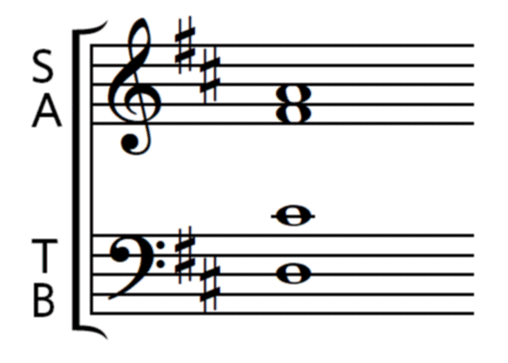 Using a tuning fork to indicate chords is difficult. Directors tend to be anxious of it, because it involves a lot of steps. First you have to understand the chord, next search for the root, imagine the right notes and sing the notes with a good intonation while looking at the voice groups. Indeed, it isn’t easy! Nevertheless, an ambitious conductor devotes time to this. On a concert, you should be reluctant to indicate the notes of an a cappella song with the piano. It just wouldn’t fit and you would look unprofessional as a conductor.
Using a tuning fork to indicate chords is difficult. Directors tend to be anxious of it, because it involves a lot of steps. First you have to understand the chord, next search for the root, imagine the right notes and sing the notes with a good intonation while looking at the voice groups. Indeed, it isn’t easy! Nevertheless, an ambitious conductor devotes time to this. On a concert, you should be reluctant to indicate the notes of an a cappella song with the piano. It just wouldn’t fit and you would look unprofessional as a conductor.
In this post, we are focusing on the order in which the notes are indicated. A lot of directors start with the soprano. After all, it is polite to let the ladies go first. And most of the times the melody lies on top. These conductors go from top to bottom: soprano, alto, tenor and finally the bass. Seems like the logical choice to make. But actually, it isn’t the best way to indicate the harmonies!
From bottom to top
In harmonic perspective, the most important note in a chord is the root. The other notes are stacked on that one. Think of an arpeggio played on the piano or guitar. Most of the times the broken chord will be played from bottom to top, starting with the root. Playing the arpeggio in the other direction will sound nice, but is not the common thing to do. Thus, the root is the starting point of all chords. The bass helps to understand the rest of the notes. The same goes for indicating notes for a choir. It is best to start with the root. And because the bass will most often sing the root, this voice group is a good starting point.
What note is next? If you start with the bass, you might go up from there: bass, tenor, alto and finally the soprano. The choir members will remember this order easily. So, this is definitely a good option. But there still are some other points to consider. The chord may have extensions, which will tend to destabilize the harmony. A major seventh for example, lying a semitone under the root, will sound dissonant. To prevent the choir members from getting confused, it is best to postpone the extensions and start with the stable elements of the harmony. After the root, the most stable note is the fifth (at least, if we are talking about the common, perfect fifth). Thus, in general the best order is: start with the root, then sing the fifth, next the third and end with the extensions.
Example
Have a look at the following chord:

If you indicate the notes from top to bottom, the singers will at first hear a wrong tonality, because the first three tones indicate the chord F#M
rather than D
. Only when the bass is sung, the choir members will get a feeling for D
. As soon as they here the final note, they will have to change their perspective on the previous notes.
If you indicate the notes from bottom to top, the tonality of D
is clear from the start. But in that case, the tone C-sharp of the tenor will confuse the choir members, because the note is very close to the note D. You might put it this way: the choir members do not yet feel enough tonality to comprehend the note C-sharp.
Thus, neither from top to bottom nor from bottom to top are really good options for indicating these notes. The best option is to start with the root and the fifth, and end with the dissonant extension:

Rule of thumb
When singing chords using your tuning fork, use this order: root – fifth – third – extensions.